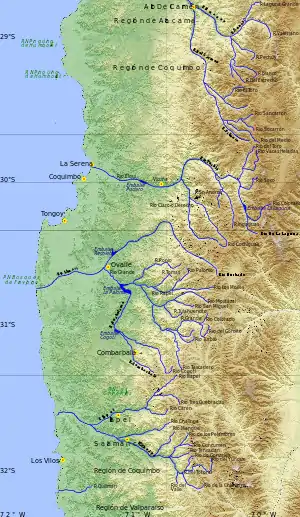Elqui River
The Elqui River starts in the west Andes and flows into the Pacific Ocean near the Chilean city of La Serena. It is a wine and pisco producing area.[2] Vicuña, the main town of the middle valley, was the home of Nobel Laureate poet Gabriela Mistral.
| Elqui River | |
|---|---|
 The Elqui River on the map | |
| Location | |
| Country | Chile |
| Physical characteristics | |
| Source | |
| • location | Junction of Turbio River and Claro River (Elqui) |
| • elevation | 815 m (2,674 ft)[1] |
| Mouth | |
• location | Pacific Ocean |
| Basin size | 9,826 km2 (3,794 sq mi)[1] |
The invasive plant species Limnobium laevigatum is present in the river which is its northernmost locale in Chile.[3]
Indigenous cultures of the Elqui Valley
About a quarter of the toponymy in Elqui Valley is of indigenous origin, overwhelmingly Quechua and Mapuche.[4] There is scant Diaguita (Kakan) toponimy known in the area despite it being considered a homeland of that people by various authors.[4] Quechua toponimy is related to valleys incorporation to the Inca Empire in the late 15th and early 16th-century. Some Mapuche toponimy posdates Inca rule, but other may be coeval or even precede it.[4] Toponyms recognised as Nahua, Kunza, Diaguita, Aymara and Taino make together up less than 10% of the all placenames in Elqui Valley.[4]
It is generally accepted that incorporation of north-central Chile to the Inca Empire was through warfare which caused a severe depopulation in the Transverse Valleys of Norte Chico, the wider Diaguita homeland.[5] Chilean toponimy in Tarija, Bolivia, including "Erqui" along with other evidence have been interpreted to suggest that Incas deported defeated tribes from Elqui Valley to southern Bolivia.[6][7] After or during conquest Incas would have settled foreign tribes in Elqui Valley,[7] and ended up imposing Quechua placenames on the local geography.[4] There is uncertainty about the date of these transfers.[4][7] Chronicler Diego de Rosales tells of an anti-Inca rebellion in the Diaguita lands of Coquimbo and Copiapó concurrent with the Inca Civil War.[8] This rebellion would have been brutally repressed by the Incas who gave rebels "great chastise".[8]
References
- (in Spanish) Cuenca del río Elqui Archived 2007-09-27 at the Wayback Machine
- "Elqui Valley Wine Region". Retrieved 21 April 2014.
- San Martín, Cristina; Contreras, Domingo; Vidal, Osvaldo; Solís, José Luis; Ramírez, Carlos (2021). "Distribución en Chile y colonización del río Cayumapu (Valdivia) por el macrófito acuático invasor Limnobium laevigatum" [Distribution in Chile and colonization in Cayumapu river (Valdivia) of the invasive aquatic macrophyte Limnobium laevigatum]. Gayana. Botánica (in Spanish). 78 (1).
- Carvajal Lazo, Herman. "Toponimia indigena del valle de Elqui". Academia.edu (in Spanish). pp. 1–16. Archived from the original on 2009-10-30. Retrieved 2022-05-18.
- Ampuero Brito, Gonzalo (1978). Cultura diaguita (in Spanish). Departamento de Extensión Cultural del Ministerio de Educación. p. 45.
- Patiño, Roberto (January 20, 2019). "Churumatas y tomatas, la conexión chilena en Tarija". El País (in Spanish). Retrieved January 20, 2020.
- Cortés Larravide, Enrique (2016). "¿Existió un grupo llamado Copiapó en el valle homónimo? Reflexiones a partir de los testimonios coloniales". Revista Tiempo Histórico (in Spanish). 7 (12): 17–32.
- Silva Galdames, Osvaldo (1983). "¿Detuvo la batalla del Maule la expansión inca hacia el sur de Chile?". Cuadernos de Historia (in Spanish). 3: 7–25. Retrieved January 10, 2019.
